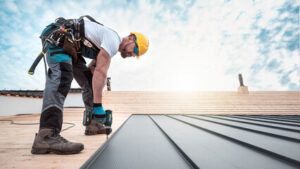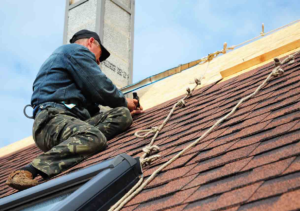A good roof is a critical component of any home. It protects the house from rain and snow, adds to the curb appeal, and increases the resale value.

To ensure that the new roof is watertight, the roofing contractor will start by waterproofing the valleys (areas where the slopes meet). Next, they will install underlayment and felt paper. Learn more by visiting https://www.bostonroofingco.com/.
The cost of roofing installation can vary greatly, depending on the type of roof and material you choose. It can also depend on the climate and aesthetic of your area. In addition, you will need to consider whether you are re-roofing or replacing an existing roof. Typically, re-roofing is less expensive than installing a new roof because it saves on labor costs.
In general, the cost of a roofing project can be divided into three categories: labor, materials, and overhead. Labor is typically the largest portion of the total cost. This can vary widely from contractor to contractor, so be sure to get a quote from several different companies.
Materials will include the shingles, underlayment, and any other necessary supplies. The type of shingle you select will also affect the overall cost of the project. For example, asphalt shingles are the least expensive and copper shingles are the most expensive.
Before the actual work begins, a roofing crew will prepare your home and property. They will set up protective measures such as tarps and wooden boards to cover anything near the roof line. They will also cover your pool and attic, move any outdoor furniture or cars out of the way, and ensure that all debris falls to the ground rather than onto paved areas. You may also need to have a rolloff dumpster parked on the street for a period of time, which can add to the cost.
Selection
Choosing the right roofing material is one of the most important aspects of a roof upgrade. It impacts the overall cost, durability and energy efficiency of a home. It also influences the aesthetics of a building. Moreover, it’s necessary to select a material that complements the existing architectural style of a property.
To achieve the desired aesthetics, homeowners need to consider the color and texture of the roofing materials. In addition, they should look for options that have high fire ratings and provide protection against ember intrusion during wildfires. They should also check with local authorities to ensure that the selected roofing material complies with zoning regulations and fire safety standards.
Roofing materials are available in a wide variety of colors, styles and textures. For example, asphalt shingles come in various shades and can blend well with other exterior features. They are durable and have a lifespan of 20 to 30 years. They are also easy to install, which reduces labor costs. Other roofing materials like wood, concrete tiles and slate offer unique textures and can fit different architectural styles. They are also highly durable and have a lifespan of 40 to 50 years. However, they are comparatively expensive and require regular maintenance to prevent mold growth and rot.
Installation
Roofing installation is more than just laying down new shingles. There are multiple steps to the process that are designed to ensure that your roof is watertight, durable, and energy-efficient for years to come.
The first step is to determine the best roofing materials for your needs. There are a wide variety of options to choose from, including dimensional shingles for durability, three-tab shingles for cost efficiency, wood shakes for natural beauty, metal sheeting for easy maintenance, and clay tiles for extreme weather resistance. Your contractor will help you select the material that is right for your home and budget.
Once the materials have been selected, the installation begins. The contractor will start by removing any existing shingles and then preparing the roof deck for the new shingle installation. This includes sanding, priming, and painting where necessary to prepare the surface for the new shingles.
Next, the underlayment is installed. The roofing contractor will overlap the first row of shingles by six inches and nail them in a pattern that alternates between close nails at the edge and more spread out nails towards the center. The contractor will continue this pattern until the rows reach the ridge of the roof.
The roofer will then install drip edge flashing and ice and water sheathing where needed. Valley flashing is also installed to defend against leaks in the roof valleys and along eaves. The roofer will also add any vents or vent holes needed for sewer ventilation, curve vents for bathroom and kitchen exhaust, or other purposes. Finally, the roofer will seal any exposed areas with roofing cement.
Maintenance
Roofing materials are long-lasting and durable, but they do need regular care to function properly. Investing in a proper maintenance plan can help your roof last longer, save energy, and protect property. It is essential to develop a plan that works with your budget and schedule.
Generally, the first step is to identify the type of roof system and its associated maintenance procedures. This will determine what equipment and tools are needed to perform the tasks. These may include a caulk gun and roofing caulking, gloves, a hammer, and a pry bar. A ladder and safety harness are also required. Once the inspection is complete, a plan should be created for ongoing maintenance to ensure the structural integrity of your roof.
Inspecting the roof surface should be done on a routine basis and is recommended by most manufacturers for their warranty to remain valid. The most common maintenance procedures include:
* Removal of Debris – The accumulation of debris restricts drainage and accelerates membrane deterioration. This is especially important around drains, scuppers and gutters. Debris can also cause damage to the mechanical systems installed on the roof. * Tree Branch Trimming – Tree branches that hang over the roof should be trimmed regularly to prevent accelerated surface erosion and prevent physical damage from wind driven movement.
The inspection should also cover the condition of all sealants and caulking, such as those at roof penetrations like skylights, vents and chimneys. These should be resealed as needed with polyurethane caulking. The flashing on the roof should be inspected and repaired as needed to keep water from seeping into the building. A new high-quality flashing should be added to any areas that are exposed and need additional protection, such as the valleys of the roof or the flashing around a skylight, vent or chimney.
